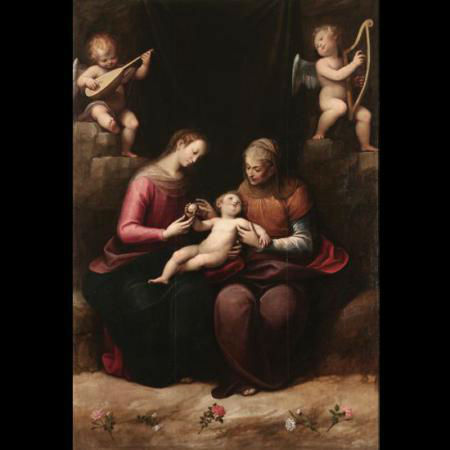St. Anne, grandmother of her savior
The National Museum of Women in the Arts, with support from The Catholic University of America and the Archdiocese of Washington, will soon open an exhibit entitled "Picturing Mary: Woman, Mother, Idea." The exhibit, which comes just in time for the Dec. 8 feast of the Immaculate Conception, will feature more than 60 paintings, sculptures and other works portraying the Virgin Mary from collections in the Vatican, the Louvre, the Uffizi Gallery in Florence and elsewhere.
The one I'm most anxious to see has never been exhibited before in the U.S. It is a painting of the Madonna and child with Mary's mother, St. Anne, by Orsola Maddalena Caccia. Mary sits beside her mother, their knees almost touching, and they hold Jesus between them. Jesus leans back and looks over his shoulder at his grandmother. At their feet are roses -- a reminder that St. Anne conceived Mary, the "rose without thorns."
Maybe my recent experience of being a grandparent has me fixated on St. Anne's part in salvation history. The Immaculate Conception, after all, is about Anne's conception of Mary, not Mary's conception of Jesus.
The Gospels don't talk about St. Anne. There were early traditions about Mary's parents, her birth and childhood written down as early as the second century, and there are icons and paintings from early medieval times. One common theme is a double Madonna, showing Anne seated or standing behind (not beside) Mary, who holds the child Jesus. (In some versions, including a famous one by Michelangelo, Mary sits on St. Anne's lap.) Another typical composition shows St. Anne teaching Mary to read.
Caccia's painting imagines a scene that is less theologically freighted but more human. That is the direction my thoughts take when I think of St. Anne. I wonder what it would have been like to raise a child like Mary, and what St. Anne made of her precocious grandson.
Surely Sts. Anne and Joachim noticed that their daughter was unnaturally well-behaved and attentive to her prayers. Was that their first indication that she was untouched by original sin? I like to think of Mary as a gangly and awkward teenager. Did she sometimes come crying to her mother that she was no good at the games children played in those days or that her hair was unattractively curly? (She might have been without fault, but she was human.)
What would her parents have thought of St. Joseph as a fiance? Mary would surely have shared with her mother the news of the Annunciation. Even for someone as saintly as Anne, that would have been cause for sober reflection.
Caccia's painting shows St. Anne as a typical grandmother. It is not surprising that Jesus' gaze is directed at her. Grandparents spoil their grandchildren, which is the way it ought to be.
When our children were growing up, we had a number of rules, which I strictly enforced. But one of the rules was that my wife's mother, who lived with us, could ignore the rules. She gave the children candy and let them watch TV with her on weekdays. She could spring them from timeouts and take them into her room. She was the engine of mercy in the family justice system.
It was an ideal arrangement, and her dispensations did not undermine the rules. The children knew what was expected of them and what constituted proper behavior. There was no entitlement to mercy -- it was a gift freely given.
St. Anne, I imagine, played that role for Jesus. How fitting that she should spoil the Son of God and teach him the virtue of mercy.
- - -
Garvey is the president of The Catholic University of America in Washington.
- Garvey is president of The Catholic University of America in Washington, D.C.



















